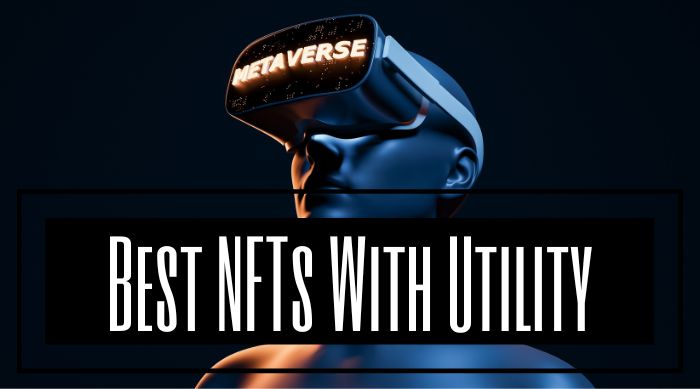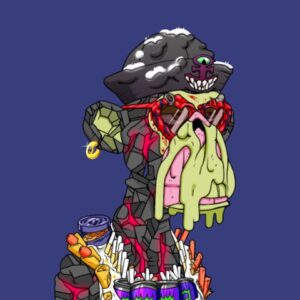What is an NFT with utility? If you think that NFTs are simply digital art or media bought and sold on the blockchain you’re in for a surprise; NFTs can be used for a variety of purposes. “Utility” simply refers to any additional purpose for the NFT aside from art or media.
The creators of an NFT may choose uses for the NFT in any number of ways. You can use one as a membership card, as a ticket to an event, or as a sort of backstage pass you can use to qualify for goods, services, and freebies. Some perks may be entirely digital, others may include real-world art or merchandise.

Those aren’t the only uses, but they are common. All of these are creator-defined options, they are not user-selected or user-modified.
NFT Utility
You’ll find a lot of lists of NFTs with utility, and many of them include lists of metaverse games such as Fractal, World of Freight, and Metakey. But the “utility” for these NFTs has much to do with facilitating gameplay. That’s not terribly attention-worthy. But when contemplating NFTs that have utility outside a single metaverse, there is far more interesting potential.
For example, World of Freight is a game with NFTs that “passively” generate in-game crypto tokens you can use to pay for upgrades in the virtual world. That sort of “utility” isn’t as interesting as the fact that this community is said to be working on an in-real-life supply chain blockchain called Supplain.
Does one project inform the other? No matter what the reality is, that project definitely brings something unique to the crypto ecosystem. What follows are NFT projects with some kind of real-world utility or a unique approach to virtual worlds and events.
Best NFTs With Utility
Some of the earliest “utility” for NFTs came in the form of avatars; if you buy a Bored Ape or CryptoPunk you could simply keep the NFT and view it from time to time, but why not use your investment as your Facebook profile picture or Twitter profile pic?
Evolving from there, some NFTs are created specifically as 3D avatars for use in a virtual world or metaverse. Vox, CloneX, BAYC, and many others offer NFTs that may serve as playable characters in these worlds. But that is barely scratching the surface for NFTs with utility. The next step in this “parade” is the ability to earn money from gameplay.
Rebel Bots is an example of a play-to-earn game using NFT utility to permit players to earn while they use the metaverse. You may be required to purchase virtual real estate in order to play to earn, and some tiers of membership may not permit you to earn through game play.
Rebel Bots is an example of how some are responding to certain trends within the industry; this game features “scholarships” to help players begin the experience without a larger up-front cost. Play-to-Earn isn’t the most innovative use of an NFT but is an evolution of one of the pioneering business models in the space.
NFTs have a lot of other potential when it comes to utility. What you see here are just some of the innovations possible. Consider Coinleague, a crypto gambling platform on Polygon which has the usual fantasy sports features but offers an NFT twist; its NFT holders may qualify for a revenue share from certain Coinleague promotions and contests.
Artist Jesse Johnson’s Eternal Royals project features an NFT that permits the owner to get a one-time-only IRL canvas print of the NFT artwork. When you claim your real-world art print, the NFT modifies itself to show the one-time-only printing offer has been redeemed.
And the art world is likely still trying to decide what to make of fractional.art and its marketplace for “fractional ownership” of popular NFTs. Essentially this platform promises you a fraction or share of an NFT artwork rather than purchasing the art outright.
In context, this is similar to what infamous KLF co-founder Bill Drummond did in real life to a photograph by Richard Long called Smell Sulfur In The Wind. Drummond took the photograph and cut it into 20,000 pieces and sold each piece individually.
VeeFriends is an Ethereum blockchain NFT project featuring NFT artwork but also “admission tokens” and “direct access tokens”. Owning certain VeeFriends NFTs provides access depending on the tier you buy into.
You may use your VeeFriends NFT to claim virtual or real-world perks, merch, and drops. Depending on the tier you buy into your NFT may serve as your admission credentials for VeeCon, an IRL multi-day convention.
CloneX creates NFTs that represent real-world high-fashion products. When you buy CloneX NFTs you get access to 3D avatar files you can use to create custom content for the avatars; these can also be used as designs for IRL clothes and accessories.
Jigen is an NFT marketplace that allows users to convert real world items into NFTs. In addition to allowing designers to create and track a product from concept to marketplace, there is also a utility coin offered which is meant to be used for staking. Arianee goes in the opposite direction, creating NFTs that represent real world luxury products and a marketplace to sell them in.
Friends With Benefits (FWB) is a bit of an anomaly in the crypto space. Many crypto projects create social clubs to support them. Friends With Benefits is a social club for researchers and thinkers that uses NFTs to fund projects and establish membership.
You purchase FWB tokens, and the more you purchase the higher your membership level. There are casual memberships all the way up to voting memberships, depending on how many FWB tokens you buy.
Flyfish Club is an exclusive, members-only club where NFT ownership is your club card and admission to a curated high-end luxury meal and other IRL social experiences. This NFT gets you into exclusive real-world spaces.
Ethereum Name Service provides “secure domain names for the decentralized world”. If that sounds promising to you, the breathless hype from some reviewer sites might make you think twice. One reviewer says this service, “Removes the need for KYC, centralized control, etc.”
That may sound too good to be true; removing Know Your Customer protocols doesn’t sound like a great idea.
It may be best to ignore the hype while learning that, with Ethereum Name Service you may be able to store a domain in a dex crypto wallet; these domains are sold as NFTs that can be traded in the usual marketplaces. The complaint in some quarters is that there is no limit to how many of these NFTs are minted.
Bored Ape Yacht Club by Yuga Labs is a good example of NFT utility that relies on the owner’s initiative rather than any inherent features in the token itself. BAYC allows the owners of its NFTs to create derivative works from those NFTs including merchandise such as t-shirts, coffee mugs and other items.
It’s possible to earn money from such derivative works but it’s all down to your own motivation to create and market such products. BAYC NFTs are some of the most popular in the crypto space and the recognition value for any derivative works may be an additional factor in how well they sell.
What To Know About NFTs With Utility
Some NFTs come with a type of utility that is fairly straightforward such as your ability to use the NFT as your all-access pass to an event or to claim exclusive merch drops.
Other NFTs have more unique uses, some of which come with marketing hype like “This is the Know Your Customer killer!” that should be roundly ignored until actual proof of such a claim is available.
No matter what kind of NFT you purchase, you’ll need to familiarize yourself with the terms of service and the basic rules for using, transferring, and sometimes even renewing your NFT’s utility.
For example, in the Rebel Bots whitepaper you will find the following fine print:
“There is no assurance that there will be no theft of your digital assets” because of hackers, fraud, or other issues. In such cases, Rebel Bots NFT owners should know,“…any of the above may lead to partial or complete theft or loss of digital assets…”
That information could be interpreted as an advance warning not to expect compensation from Rebel Bots for any activity described above that leads to the loss of your NFT, game progress, earnings, etc.
NFT Fine Print Terms You May Need To Know
And reading the fine print is important in other ways, too. Some NFTs have utility that is time-sensitive; like any other membership your utility may expire over a period of time. Can you renew? That will depend greatly on the individual terms of service for the NFTs you purchased.
And finally, read the fine print for another very important reason–you may be restricted in how, when, or to whom you transfer utility NFTs. Is your membership non-transferable? In some cases that may be true.
Some NFTs, such as Damien Hirst’s The Empress, ask you to choose between keeping the NFT and destroying a piece of IRL art or keeping the real-world artwork and burning the NFT. This must be done within a fixed time frame. If you sell the NFT instead, the new owner must choose within a similar fixed amount of time.
If you didn’t know that going into the purchase of this artwork, you may be surprised to learn you have to act in order to maintain your ownership of the work in one form or another. Reading the terms and conditions of sale and ownership is key for many utility-based NFT projects like this.
Joe Wallace has covered real estate and financial topics, including crypto and NFTs since 1995. His work has appeared on Veteran.com, The Pentagon Channel, ABC and many print and online publications. Joe is a 13-year veteran of the United States Air Force and a former reporter for Air Force Television News.


